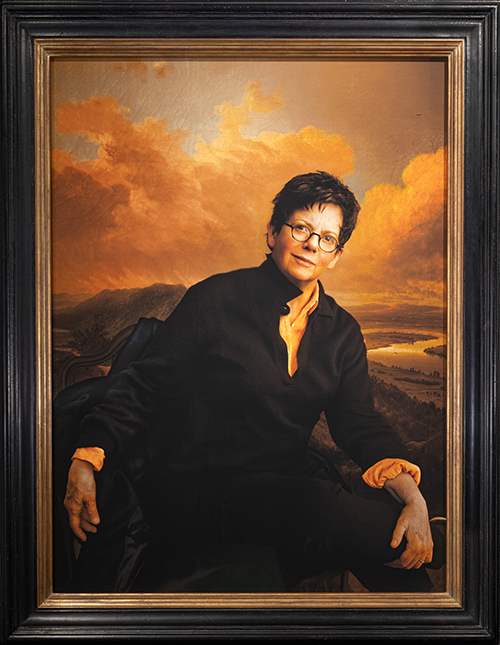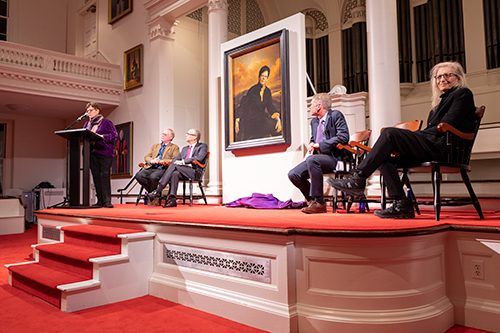The official portrait of President Emerita Biddy Martin breaks tradition as the first photograph to hang in Johnson Chapel. And it’s not just any photograph—it’s by Annie Leibovitz. She spoke with Amherst magazine senior editor Katharine Whittemore in the chapel shortly before the Dec. 9 unveiling.


The Leibovitz portrait (top), and Martin speaking at the unveiling, with Leibovitz at right.
The Idea
Leibovitz has photographed everyone from John Lennon to the Obamas to Serena Williams. In 2019, Amherst awarded the artist an honorary degree. “I remember sitting on the commencement stage,” she says. “I had just met Biddy. I was sitting behind her on the podium. I looked at her and was admiring her. I got her attention and said, ‘I’d
really like to take your photograph.’ And I never do that!”
The Shoot
Leibovitz and Martin met for several photo sessions on campus. Leibovitz had the idea of featuring a landscape in the background, but later decided to capture an image of a landscape painting rather than to photograph a scene herself. “After each shot, she would change something,” said Martin at the unveiling in the chapel. “Being able to witness the process has been one of the most incredible things of my life.”
The Backdrop
The painting in the background is The Oxbow of the Connecticut River, by an unknown artist. Leibovitz photographed it, then cropped her photo and adjusted the colors. At the unveiling, Nicola Courtright, the William McCall Vickery 1957 Professor of the History of Art, noticed that the cracks in the paint show through in the photograph, making the entire portrait of Martin resemble a painting. “It’s a brilliant move,” Courtright maintains, “to make the portrait very much like a painting, so that it finds its proper place in this group of portraits in Johnson Chapel.”
The Pose
“I was going in a very formal, traditional route, based on the other Johnson Chapel portraits,” Leibovitz says. “And then she sat like that, using her leg as a sort of table. I thought it was a very modern pose.”
The Art History
“To me, it utterly fits in the tradition of Grand Manner portraiture,” says Courtright. “There’s an important sitter on a high promontory, yet placed close to the viewer, overlooking a noted landscape down below. The point of placing a subject of this sort—a leader—above a landscape that represents a familiar landmark (here, the Oxbow) is to show their command over all they survey.”
The Artist’s Take
“From beginning to end, it was a difficult process: the whole of how to determine what to do, how to do it, what it should look like, how it should be framed, what was the background. It was a total immersion!” Leibovitz says. “It was so wonderful to come out with something that one likes. It doesn’t happen very often for me. I’m always rushing and having to compromise in some way.”
The Chapel
“This is for here, unique for Biddy, for Amherst, for this room,” Leibovitz says. “I loved working on something like that. But it’s a big responsibility. It’s not a magazine or a newspaper or even a book, where you can put it aside. I felt it was so important that this be done right, because it’s going to be here until the end of time.”
Top photo: Annie Leibovitz; Bottom photo: Jesse Gwilliam